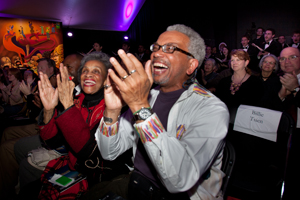Groundbreaking art
A ceremony showcases the Logan Center and proves that, in theory and in practice, UChicago digs the arts.
By Brooke E. O'Neill, AM'04
Photography by Dan Dry

Bravo: Diasporal Rhythms President Patric McCoy, AB'69, celebrates at the May 12 groundbreaking for the Reva and David Logan Center for Creative and Performing Arts.
As the early-evening sun peeks through window blinds, a small group of graduate students and faculty members sit in a dark Cobb Hall classroom, peering at even darker images. Ominous gray clouds flanked by pitch-black sky fill the large flat-screen TV in the corner of the room.
"It's hard to say which way is up and which is down," says art-history graduate student Phil Lee, describing the disorienting photograph at an April meeting of the Contemporary Art Workshop (CAW). The image, one of Alfred Stieglitz's 200-plus cloud shots, is part of Lee's evolving dissertation on photography's importance in American modernism.
At today's meeting, she's testing her ideas—and being pushed to question them. Associate Professor in Art History Darby English, a faculty adviser for the group, urges Lee to rethink whether to include a chapter describing the historical context of Stieglitz's work. "Some contemporary work is important precisely because it is contemporary," English says.
The University's approach to arts scholarship encourages students like Lee to tackle topics with little historical precedent. Whether debating a philosophy of aesthetics or assembling a sculpture exhibition, says CAW faculty adviser Matthew Jesse Jackson, UChicago artist-scholars have the flexibility to "find what's crucial in the process of doing the research, to be open, and to have absolute freedom to follow those intuitions, those observations in any direction."
"That's why," adds Jackson, an associate professor in art history and visual arts and the College, "I'm truly excited about the idea of the Logan Arts Center."
That excitement spread throughout the University community on May 12. A daylong celebration of Chicago's combination of theory and practice culminated with the 6 p.m. groundbreaking ceremony for the Reva and David Logan Center for Creative and Performing Arts.
A standing-room-only audience filled a tent at the corner of 60th Street and Ingleside Avenue. David Logan, AB'39, JD'41, and his family, whose $35 million gift made the building possible, were the honored guests as campus and civic-arts leaders envisioned the impact it would have after its 2012 opening. Describing his father's vision, Daniel Logan said, "The building is just the beginning. He's interested in changing lives."
The University Symphony Orchestra, Motet Choir, and Jazz X-tet provided the entertainment, and speakers included actress Marilu Henner, X'74; Court Theatre artistic director Charles Newell; and Chicago art scholar, administrator, and poet Ronne Hartfield, AB'55, AM'82.

The University Symphony and other campus groups gave groundbreaking performances.
Before and after the groundbreaking, performances and panels highlighted how the arts fit into the contemporary campus culture. At the Reynolds Club, the a capella group the Ransom Notes sang tunes such as "Don't You (Forget About Me)," while theater, dance, and film students showcased their work throughout the building. In the third-floor Francis X. Kinahan Theater, a faculty panel discussed the evolution of the arts at the University.
If the arts were once an afterthought, dismissed as an extracurricular diversion from more serious work, the Logan Arts Center will be an 11-story, 170,000-square-foot symbol of how much that perception has changed. "What's happening now is a recognition and, if you will, a consensus that art has a place on campus and it will not contaminate or dilute the intellect," says music professor and pianist Thomas Christiansen. "On the contrary, it could be a catalyst."
To professors such as Christiansen, who combine scholarship and performance, there is no meaningful distinction between theory and practice. "Intellectual work is tantamount to creative work," says photographer Laura Letinsky, associate professor in visual arts and cinema and media studies. "The kinds of production done here, be it written, performed, filmed, painted, et cetera, are understood as research, argument, catalyst, knowledge, and provocation."
Best known for her still-life tableaux inspired by fields as diverse as child development and identity philosophy, Letinsky sees the Logan Center as a chance for more powerful, multidisciplinary discourse. Just being in "simple physical proximity with my fellow faculty," she says, "will enable an organic cross-fertilization" that would be difficult if faculty were dispersed among many buildings.
"Having everyone under the same roof is going to generate a broader conversation," agrees painter David Schutter, MFA'03, an assistant visual arts professor. He envisions the center as a place for faculty and students to "extend their ideas." As more art hybrids emerge in the larger contemporary art world, he says, the Logan Arts Center will help artist-scholars to fuse vision, sound, and discourse in ever-more groundbreaking ways. The UChicago faculty-produced virtual curatorial project, ourliteralspeed.com, which combines audio, text, and video to present art and historical events, is one example of that trend.
The Logan Center's open space isn't just for experimental endeavors. Blending artist studios with a black-box theater, classrooms, media labs, music rehearsal rooms, galleries, and other performance and film-screening venues, the center will encompass multiple realms—and eras—of creative exploration and critical study.
"If you're interested in past styles, work that is canonical and traditional, that's great," says Jackson. "'Open' implies an openness to the past, the present, and the future." Whether analyzing Stieglitz's abstract cloud photos like Lee or painting still-life works like Schutter, each person will chart his or her own unique path in the center's flexible, fluid environment.
"Everyone imagines [the center] as a space that will produce objects and experiences-and we literally can't imagine what they might be," muses Jackson. A decade from now the results will be obvious, he says, "but now, no one really knows. And that's what's most wonderful about it."
Return to top
WRITE THE EDITOR
E-MAIL THIS ARTICLE
SHARE THIS ARTICLE
ALSO IN CHICAGO JOURNAL
RELATED LINK
- Video and photos from the groundbreaking ceremony
